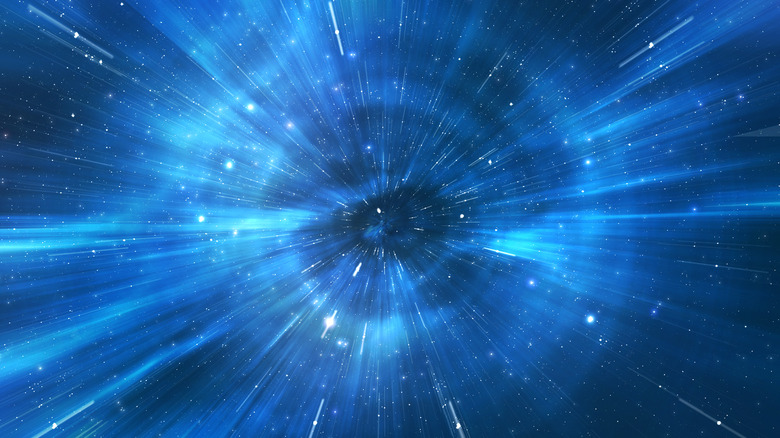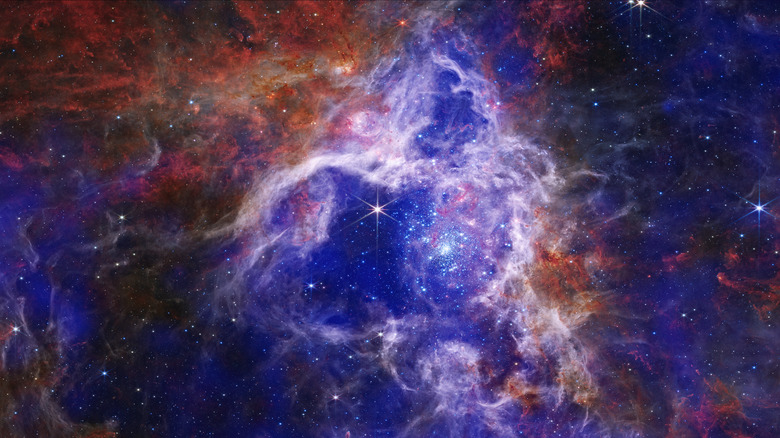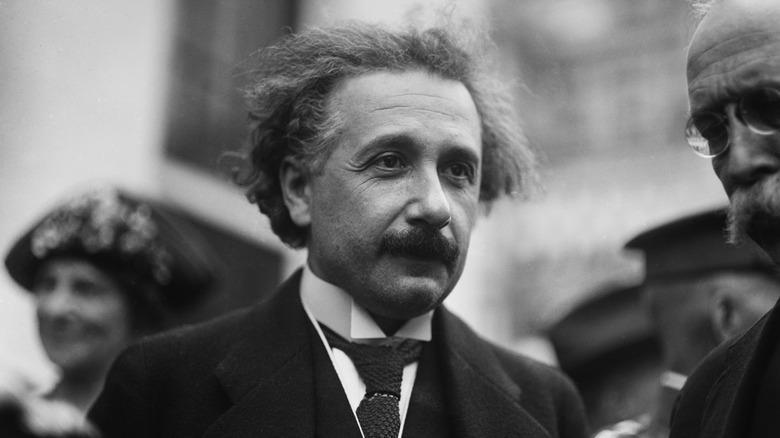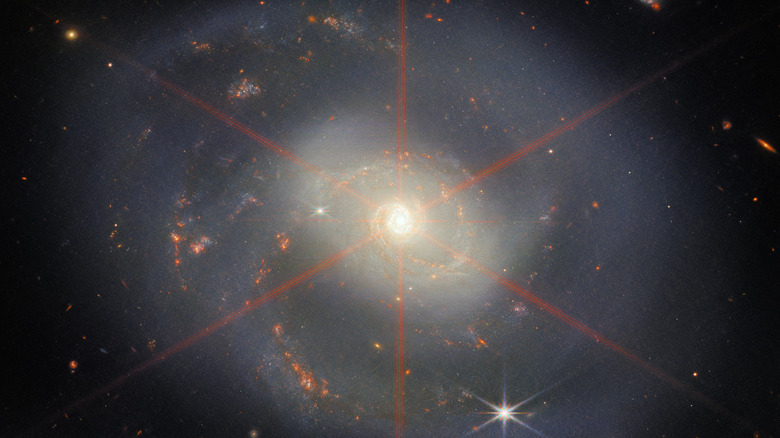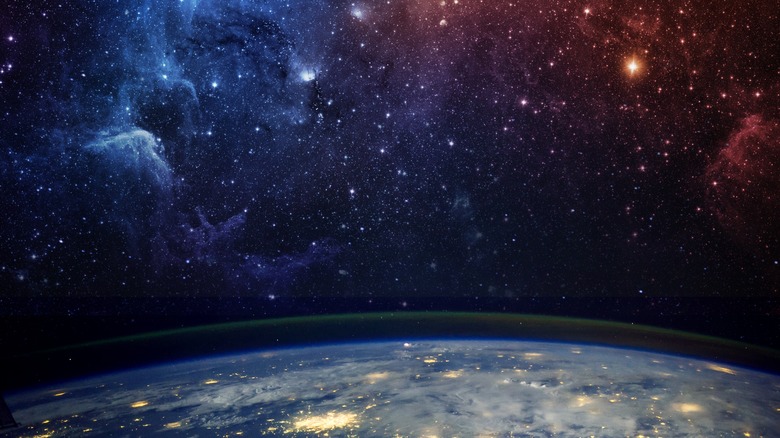Why Can't We Go Faster Than The Speed Of Light?
Warp drive: it's the dream of every would-be space explorer and "Star Trek" fan. How much easier would it be to zip around the cosmos like a jet ski on a lake? Our current fastest ship — the NASA-Germany Helios probe — goes 250,000 kilometers per hour. Pretty fast, right? Well, as Science says, it would take 18,000 years to reach our nearest neighbor star, Alpha Centauri, 4.4 light years away. Our entire Milky Way galaxy is about 100,000 light-years across and contains up to 400 billion stars, as NASA says. And our one galaxy? It's only one of about 2 trillion in the observable universe, which itself is 1/250th of the entire universe (per Big Think and Space.com, respectively). So are we going to explore space without something faster than rockets? That's a supermassive no.
But how about some wormhole or faster-than-light technology? Einstein's often-quoted E = mc2 equation indicates that nothing can go faster than the speed of light in a vacuum. But why, exactly? Sites like Live Science say that an object moving at the speed of light would have infinite mass. That's true, but it doesn't describe why we've got a cosmic speed limit to begin with. What's the reason for the barrier? In the end, the speed of light is a physical property of space, not a description of how fast light moves. In fact, if you're sitting still while reading this, you're already moving at the speed of light ... through time.
Light from the past
As Space.com cites, the universe is 13.8 billion years old. After the Big Bang, the universe inflated like a balloon and scattered elementary particles everywhere. Those particles cohered into the first galaxies and stars, and now after a long, long time, we humans can write and read articles like this one. Meanwhile, the universe has never stopped expanding and — by current estimates — will continue to expand forever, as sites like Big Think outline. But if we humans have only existed for a speck of time, how do we know any of this? The answer is the key to all subsequent inquiry: light.
Thanks to a wonderfully helpful cosmological feature, light takes some to travel. This is how we can glimpse the origins of the cosmos. Light isn't slow — 299,792,458 meters per second, per Space.com. Space is just that big. If something is 186,282 miles away from Earth, it takes one second for its light to reach us. If something is one light-year away, it takes one year to reach us; the light we see shows us what the object looked like one year ago. This is why when the newly-launched James Webb Space Telescope peers into space, it's glimpsing the past — all the way back to a scant 100 million years after the Big Bang, as NASA says. That is, it's glimpsing our past. Space and time are relative and depend not only on the location of the observer but also on the observer's speed.
Einstein's time dilation
Out of all the humans who've lived, one of them — Albert Einstein — took up such questions about space, time, observer location and speed, and the speed of light with absolute alacrity. Space and time, he said, are not separate things. They're one synthesized whole: spacetime. Time isn't just a perceptive human experience — it's a fourth aspect of space. The fourth dimension, along with length, width, and height. Einstein described such thinking in 1905's theory of special relativity, which contains his famed E = mc2 equation, as Space.com describes. The entire theory hinges on the equation's "c:" the speed of light. "C" means constant, meaning that the speed of light is an absolute, unchanging value everywhere and always.
It's time that changes, Einstein said. On Earth, everything is packed closely enough and moves slow enough — relative to each other and the Earth's spin of 1,670 kilometers per hour — to not sense any difference in time between objects. Would time change for someone in a 200-mile-per-hour Formula 1 car? Not nearly fast enough. A Mach 3 jet? Not even close. You've got to approach "c" itself, the speed of light — 299,792,458 meters per second — for time to speed up or slow down for one observer, a phenomenon known as "time dilation," as Live Science explains. Time slows down for objects approaching the speed of light. And at the speed of light? Time stops altogether.
The timelessness of light
Let's dig a bit deeper into this whole E = mc2 thing. Some say it's a way to describe the equivalency between mass and energy, to say that they're equivalent under certain circumstances. In reality, as Space.com explains, the equation means that objects with mass ("m") require infinite energy ("E") to reach the speed of light ("c"). This is impossible. Objects at light speed also gain infinite mass, as we mentioned earlier. This is also impossible. Ultimately, E = mc2 is shorthand for "things with mass can't move at the speed of light."
From here, let's go quantum. Folks might remember three subatomic particles from grade school: protons, neutrons, and electrons. These particles, we're taught, compose all matter. That's true, but protons and neutrons themselves are composed of other, smaller particles. Quanta Magazine has wonderfully helpful charts and diagrams that show us the full, current, quantum realm: fermions (matter-based particles like quarks and leptons) and bosons (particles that carry force). It's all incredibly complicated, but for our purposes, focus on mass. Three particles have zero (or almost zero) mass: neutrinos, gluons, and photons.
Photons are light particles, the kind emitted by our sun or detected by the James Webb Space Telescope when photographing the early universe. Because photons have no mass, they travel at the speed of light. And remember we said that objects at light speed stop experiencing time? Yes, that means that objects with zero mass don't experience time. To light, per Phys.org, light is eternal.
Hurtling through time at light speed
And so we come to the reason for the light-speed barrier. We said that zero mass means light speed, and more than zero mass means less than light speed. Put differently — an object at rest still moves through time. But the more you move through space, the less you move through time. You can move through one or the other, but at a cost to the other, as Big Think outlines. In other words, the Big Bang was the moment when all objects started moving through spacetime at the speed of light. Right now, you're being hurtled through time at the speed of light, physically. Physicist Sabine Hossenfelder, amongst others, breaks down the math behind this on her YouTube channel.
Here's an analogy to help explain: Imagine you're driving along a straight line and want to change direction. You'd have to apply force to do so. If you angle your car a bit to the right instead of along the road, you'd still reach a straight-lined border in the distance. This is true even if you angled your car 89-degrees of center, provided you were driving along a wide-enough plane. But if you turned your car 90 degrees, then you'd stop moving forward, right? This is like time stopping at light speed. For an object that has mass, the force needed to divert 90 degrees of center would have to be infinite. This is what E = mc2 means, and why we're locked at sub-light speeds.
A baked-in cosmic value
This brings us to our final question: Why is the speed of light "c"? Why 299,792,458 meters per second and not 299,792,457? First off, such a figure appears oddly specific simply because of how we happen to measure things like distance in meters. If we measured distance using another unit entirely, like "blarkthark" or something, the speed of light might not appear so peculiar.
More importantly, as Aeon describes, the speed of light — the ability of a massless object to move without experiencing time — is a fundamental aspect of the universe's construction, same as gravity, quantum fields, and the properties of the subatomic particles described earlier (via Quanta Magazine). Astrum on YouTube postulates that the exact number derives from the curvature of spacetime; its physical shape. Beyond such explanations, we can only say: that's just the way it is.
That being said, it's a good thing that we can't reach or exceed the speed of light, otherwise we'd break causality. Think about it: If you arrived at a location sooner than light arrived, what would you see? What would anyone else see if they looked at your supposed location? PBS Spacetime on YouTube, in fact, defines the speed of light more accurately as the "speed of causality," and this is completely true. Besides, who wants to be stuck in the timeless infinity of light, perceiving no beginning and no end, only an unchanging eternity? Best be glad for your mass.
